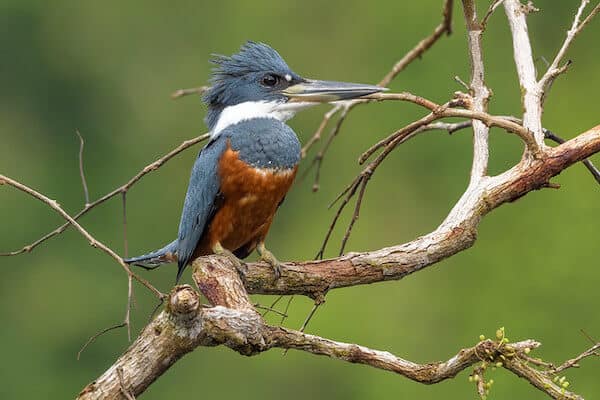Kingfishers are very easy to recognize. Their powerful bills allow them to spear fish when they dive into the water, and their colorful feathers glitter just like the streams they love to perch above. Found worldwide, these unique looking birds are always fun to watch. In this article we explore 14 facts about kingfishers and how they are unique in the animal kingdom.
14 FACTS ABOUT KINGFISHERS
1. THERE ARE ABOUT 114 SPECIES OF KINGFISHERS.
Kingfishers live on every continent but Antarctica. Most species live in the eastern parts of the Old Word, that is, Asia, Africa, and Australia.
Southeast Asia and the Australian islands region have the highest concentration of kingfishers.
A handful, however, live in western Europe and the Western Hemisphere. North and South America are home to just six species of kingfisher. Only three live in Europe. We outlined a few species in this article if you want to learn more about the different species.
2. KINGFISHERS NEST IN UNDERGROUND BURROWS OR TREE CAVITIES.
It may surprise you to discover that many kingfishers nest underground. Most birds choose to raise young in the safety of the trees, but these water-loving birds developed another way to keep their eggs and chicks safe.
Males and females work together to excavate a burrow from a sandy riverbank. It has one tunnel which ends in a round chamber. When kingfishers return to their nests, they fly at high speed directly into the disguised hole in the riverbank.
Kingfishers which prefer to nest in tree cavities choose trees close to the water. They want to be close to sources of food to bring back to their hungry chicks.

3. THERE ARE THREE CATEGORIES OF KINGFISHER: WATER, RIVER, AND TREE KINGFISHERS.
The three groups of kingfishers are divided up mainly according to their diet and habitat.
Tree kingfishers are less reliant on water than the other two groups. They prefer to eat small lizards, mammals, insects, and worms. They also nest in trees instead of burrows. Being close to water isn’t a requirement for them.
River kingfishers’ rely more on fish for food, but they also eat frogs, insects, spiders, flies, and tadpoles. They perch and dive for their prey in rivers and streams. They are also known as ‘pygmy’ kingfishers because of their smaller size.
Water kingfishers share many traits with the river kingfishers, but they rely solely on fish for their food source. They prefer to nest in burrows, where they are close to food sources. They are often the biggest kingfishers, able to catch larger fish.
4. KINGFISHERS LIVE ON EVERY CONTINENT EXCEPT ANTARCTICA.
Where there is water, there is probably a kingfisher. These hardy birds inhabit freshwater rivers, streams, and wetlands. Some live in coastal marshes with a mix of saltwater and freshwater.
Their distribution around the world depends on what subfamily of kingfisher. Only water kingfishers are native to North America. The river and tree kingfishers live in Asia, Europe, sub-Saharan Africa, and Australia.

5. THEY ADAPT WELL TO HUMAN DEVELOPMENT.
Kingfishers are shy but they take advantage of human-made canals and waterways to fish, build their nests, and raise young. This type of stream development can worsen or improve conditions for kingfishers.
Channelization is one such negative activity that destroys kingfisher habitat. When cement is overlaid in a riverbed, foliage which the kingfisher perches on cannot grow. Fish rarely survive, and the nesting habitat is covered up.
Kingfishers are not attracted to bird feeders, but you may spot one on a walk near a rural stream in the morning or evening.
6. MALES AND FEMALES LOOK VERY SIMILAR.
When the male and female of a same species look different, they are called sexually dimorphic. Like a male and female Northern Cardinal, which look quite different. Some kingfishers are sexually dimorphic and some are not. It depends on the species of kingfisher.
However many of the kingfishers that are sexually dimorphic still look similar. For example the Belted kingfisher female looks identical to the male except for a single copper band across her chest.

7. THEY IMPALE THEIR PREY WITH THEIR BILLS.
Kingfishers use their sharp bills and strong head and neck muscles to impale their prey. They do this by diving into streams and rivers at high speed while aimed at their prey.
A slippery fish can wriggle out of a beak, but it has no chance of escaping if it is impaled on a kingfisher’s sharp bill.
Once the bird catches its quarry, it eats it whole. Some kingfishers beat the fish against a rock or limb to kill it before swallowing.
8. KINGFISHERS ARE MOST ACTIVE IN THE MORNING AND EVENING.
Dawn and dusk are high-activity times in the animal kingdom. This is especially true for kingfishers, which rely on the movement of fish and invertebrates to hunt and catch their meals.
In the morning and evening, temperatures are cooler and invertebrates, frogs, and fish are more active than at night or in the middle of the day. The kingfisher stays hidden in shadows more easily so it doesn’t frighten its prey.

9. KINGFISHERS ARE AMBUSH PREDATORS.
Kingfishers perch in wait for the perfect moment to strike. Most fish-eating kingfishers find a branch that hangs out over the water, and sit perfectly still. They zero in on movement under the surface of the below stream or river and wait.
Once they spot an opening, they dive at high speed into the water, spearing their prey on the tip of their beak or grabbing it in a tweezer-like motion. This method of hunting requires strong eyesight, fast flying skills, and patience.
10. THEY HAVE DISPROPORTIONATELY LARGE HEADS AND BILLS.
Kingfishers’ heads and bills are disproportionate with their bodies. They have well-developed musculature that supports their neck and protects their brain from high-impact dives.
Their large skull supports powerful eyes, which locate prey under the water.
One amazing adaptation of kingfishers is the ability to keep their heads completely still as their perch moves with the wind. This ability to focus is called vision stabilization.
11. THEY HAVE HYDRODYNAMIC BEAKS.
Their large, sword-shaped beaks evolved to be optimal for their diving hunts. Kingfisher beaks are wedge-shaped, with long pointed tips. This cuts into the water with minimal splash, noise and water disruption so as to not alert the fish that they are coming.
If their beaks were rounder, like a duck, water would be pushed ahead of the beak as they dove, slowing them down and alerting the fish, giving them that extra second to get away.
Japan took notice of this efficient design, and used it as a model for their new bullet train. By modeling their train shape after the kingfisher’s bill, they cut down on air pressure and wind noise, also increasing speed.

12. THEY CAN DIGEST BONES.
Kingfisher chicks are born with extremely powerful stomach acid. They need it to digest the bones, scales, and shells of the fish and invertebrates their parents feed them.
Once they mature into adults, their stomach acid grows less powerful. Adult kingfishers spit up bone pellets, similar to owls. Scientists can study their diets by searching for pellets near streams and perches.
13. ONLY ONE SPECIES OF KINGFISHER IS COMMON IN THE UNITED STATES.
The only common kingfisher in the U.S. is the Belted Kingfisher. They can be found year-round throughout most of the U.S. Some head north to breed across Canada and Alaska, then move south in the winter to the southern U.S. and Mexico. This species is a water kingfisher, so look for them in the U.S. along streams, shorelines and even ponds as long as fish are plentiful.
The Amazon kingfisher, Green kingfisher and Ringed kingfisher are rare in the U.S., and are only seen in places like Texas, along the far southern border with Mexico.
14. MONOGAMOUS PAIRS RAISE CHICKS TOGETHER.
Every year, kingfishers meet up and pair off into couples. These pairs are monogamous for just the season, so every year they find new mates.
Mated pairs dig the burrow or furnish the nest cavity, hunt, and incubate their young together. In some species, only the female incubates the eggs.
Both males and females are extremely territorial. A mated pair defends its territory together, usually from other kingfishers.








